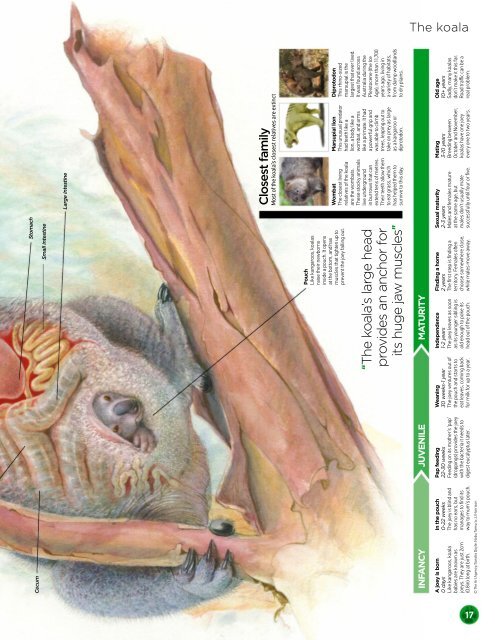World_of_Animals_Issue_46_2017
Create successful ePaper yourself
Turn your PDF publications into a flip-book with our unique Google optimized e-Paper software.
The koala<br />
Cecum<br />
inFanCy<br />
a joey is born<br />
0 days<br />
Like kangaroos, koala<br />
babies are known as<br />
joeys. They are just 2cm<br />
(0.8in) long at birth.<br />
in the pouch<br />
0-22 weeks<br />
The joey is blind and<br />
has no ears, but<br />
manages to find its<br />
way to mum’s pouch.<br />
© The Art Agency/Sandra Doyle; Nobu Tamura; JJ Harrison<br />
JUvenile<br />
pap feeding<br />
22-30 weeks<br />
Feeding on its mother’s ‘pap’<br />
(droppings) provides the joey<br />
with the bacteria it needs to<br />
digest eucalyptus later.<br />
Stomach<br />
Small intestine<br />
Large intestine<br />
Closest family<br />
Most <strong>of</strong> the koala’s closest relatives are extinct<br />
pouch<br />
Like kangaroos, koalas<br />
raise their newborns<br />
inside a pouch. It opens<br />
at the bottom, and has<br />
muscles that tighten up to<br />
prevent the joey falling out.<br />
“The koala’s large head<br />
provides an anchor for<br />
its huge jaw muscles”<br />
wombat<br />
The closest living<br />
relatives <strong>of</strong> the koala<br />
are the wombats.<br />
These stocky animals<br />
live underground<br />
in burrows that can<br />
extend tens <strong>of</strong> metres.<br />
Their teeth allow them<br />
to eat grass, which<br />
has helped them to<br />
survive to this day.<br />
Marsupial lion<br />
This unusual predator<br />
had teeth like a<br />
lion, a body like a<br />
wombat, and arms<br />
like a primate. It had<br />
a powerful grip and<br />
was able to climb<br />
trees, leaping out to<br />
take on prey as large<br />
as a kangaroo or<br />
diprotodon.<br />
Diprotodon<br />
This rhino-sized<br />
marsupial is the<br />
largest that ever lived.<br />
It was found across<br />
Australia during the<br />
Pleistocene (the Ice<br />
Age), more than 11,700<br />
years ago, living in<br />
a variety <strong>of</strong> habitats,<br />
from damp woodlands<br />
to dry plains.<br />
MaTUriTy<br />
weaning<br />
30 weeks-1 year<br />
The joey ventures out <strong>of</strong><br />
the pouch and starts to<br />
eat leaves, coming back<br />
for milk for up to a year.<br />
independence<br />
1-2 years<br />
The joey leaves as soon<br />
as its younger sibling is<br />
old enough to poke its<br />
head out <strong>of</strong> the pouch.<br />
Finding a home<br />
2 years<br />
The first step is finding a<br />
territory. Females <strong>of</strong>ten<br />
choose somewhere close,<br />
while males move away.<br />
Sexual maturity<br />
2-3 years<br />
Males and females mature<br />
at the same age, but<br />
males don’t usually mate<br />
successfully until four or five.<br />
Mating<br />
3-10 years<br />
Breeding between<br />
October and November,<br />
koalas have one joey<br />
every one to two years.<br />
old age<br />
10+ years<br />
Sadly, many koalas<br />
don’t make it this far.<br />
Road traffic can be a<br />
real problem.<br />
17


















